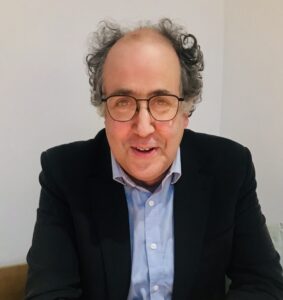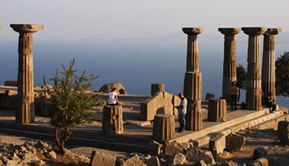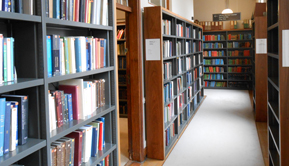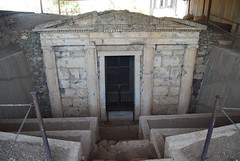Tom Harrison is the new Keeper of the Department of Greece and Rome at the British Museum, an Associate Fellow of the Institute of Classical Studies, and an Honorary Professor at the University of Liverpool. He has broad interests in the history of the archaic and classical Greek and Persian worlds, and in the history of scholarship. His research has focussed on the ways in which the Greeks understood and interacted with foreign peoples, how they understood the role of the divine in ordinary life, the historiographical vision of Herodotus, or the complex thought-worlds of scholars of antiquity from the nineteenth century through to today. He talks to Caroline K. Mackenzie for ARGO.
 (© Tom Harrison)
(© Tom Harrison)
I was lucky to be exposed to Classics from a young age. One of the first books I remember was a book of myths by Roger Lancelyn Green. I can’t remember which it was, but the picture of the Trojan Horse on the front cover is burnt into my mind. When I was about 10 or 11, a few things happened at once. It was around then that I began Latin. We went on a school trip to Fishbourne Roman Palace. And Rosemary Sutcliffe came to talk at my school in Chichester about her book, Eagle of the Ninth. I have a mental image of her in a wheelchair by a fireplace, surrounded by little boys sitting cross-legged. She wasn’t a dramatic speaker in any way, but she was mesmerising. It was around the same age that I picked up an old Penguin of Herodotus (the very dated de Selincourt translation), and was drawn in and then defeated by all the Lydian names in Book 1. I do remember visiting the British Museum as a very small child, but to be honest what I remember most was waiting around on the colonnade in the cold, waiting to go in, and how imposing the building was!
Later, at school, I wavered between History and Classics. I then studied Ancient and Modern History for my degree at Oxford. There were some linguistic elements to the degree (I did papers on Herodotus and on Arrian, I think), but no one ever asked if you could read Greek. Modern History for me meant Medieval: Late Roman, Byzantine, Anglo-Saxon history. I just made it to 1066 for my last ever essay, which was on the psychological effects of the Norman Conquest. Doing Medieval history was particularly important for me, I think, as it gave me a wider sense of what history could encompass. At school I was made to read lots of work by the medievalist R. W. Southern (our teacher was his son, Peter); and I think my interests in religion – the way, for example, that a ‘believer’ can forge documents or (in the ancient case) make up oracles, go back to that. A particularly pivotal moment for me was in that last term of Anglo-Saxon history. We’d been studying saints’ lives for five or six weeks, and other students had been telling me about their very serious-sounding essays on Offa and the Mercian kingdom. So I asked my tutor, Henrietta Leyser, if we should be doing the Mercian kingdom too. She gave me a Paddington stare, and replied: “Oh, you’re not getting worried about what happened are you?” I never looked back. She was a magnificent teacher.
I don’t remember ever making a choice to go into academia. I just wanted to dig deeper. I knew I wanted to look at religious belief (I called it religious ‘ideology’ then), but didn’t know how or where to look, so it took me a long time to find my topic. I might have worked on Isocrates (a lucky escape), Lycurgan Athens, all sorts of things, and then landed back on Herodotus. Initially I was supervised by the epigraphist David Lewis, which I can’t pretend was always easy, although his interventions were always incredibly acute; I then moved to Robert Parker, who was an exemplary supervisor.
I didn’t find it at all easy to get a job at first. I did some part-time teaching at Royal Holloway and UCL when I was finishing up, and then landed a two-year post at St Andrews. Those two years were really transformational for me. I delivered an absurd number of lectures. (They were bunched into one semester, and I remember I had to do 45 lectures before Reading Week). But I learned how to do the job. And teaching, having to communicate my thoughts to an audience, taught me how to communicate in writing, too. Essentially, if what you were saying wasn’t comprehensible, it wasn’t worth saying. There was also a fantastic research seminar, much more intellectually open than at Oxford. (Stephen Halliwell was a force of nature in those seminars, and was incredibly encouraging to me personally). I have actually been at St Andrews three times – as a post-doc, as a lecturer, and then most recently from 2015 until 2023 – which I think shows how important it is to me!
The end of January 2024 marked one year into my new job at the British Museum. It is a great job with huge potential. I’d worked with museums especially in my ten years at Liverpool. We had a wonderful small museum in the department (the Garstang Museum) which I was involved with, and then in my final years I had responsibility for the university collections more widely – though it was more focussed on governance than hands-on. So doing a job like this is definitely a new departure, and not something I could have dreamed of doing!
The transition from academia to museum life is not too much of a shock! The Museum is an extraordinary intellectual community. (It’s the most amazingly overqualified workforce you could imagine). And we are fundamentally in the same business of research and teaching, only with a different, wider audience in mind, and different ways of ‘teaching’: displays, exhibitions, public events, events for patrons and members. I have done little bits of teaching of undergraduate and Masters students and I’m carrying on with PhD supervision, so there are some elements of overlap. I do miss the buzz of giving lectures regularly, though!
I don’t pretend to be an archaeologist. I am getting to know the collections slowly, but they are so extraordinary that you can only ever scratch the surface. So I am very dependent on my fantastic colleagues and their breadth of experience. What I hope I bring is the broader view of the historian, and an outside perspective. In the coming years, the Museum is planning a huge redisplay of its ancient world collections, so the challenge is going to be to tell new stories – and I hope I can help with that. The planning for this is now really beginning in earnest.
The debate over the Parthenon Sculptures is inevitably part of the job. It’s well-known, of course, that the Chair is committed to finding a way forward, and I am unreservedly supportive of that effort. As an ancient historian, first and foremost, what I care about is how to do the best job possible of explaining and contextualizing the sculptures. The current situation doesn’t always help in doing that. George Osborne has talked about how we shouldn’t shy away from topics of controversy, and that is something that I passionately agree with.
It is very difficult to give an exact figure for the proportion of the Museum’s collection which is on display. We tend to say that the museum includes 8 million objects, with around 80,000 on display. But it rather depends on what you count as an object! If, for example, you have a set of half a million cigarette cards, or a box of a hundred gold leaves that once made up a wreath, do these count as single objects or do we count every last item? These are real examples! We also send out thousands of objects on loan every year. In the redisplayed galleries, I really hope that the space will allow for more flexibility, more rotation of the collection.
The Herodotus Helpline is probably the thing that I am most proud of. The idea for it emerged just before the first lockdown in 2020, as we were beginning to hear desperate news from friends and colleagues in Italy. I got in contact with my friend Jan Haywood, now at Leicester, and asked how he’d feel about doing it with me. Jan has amazing energy and warmth as well as being very practical, so it couldn’t have happened without him. In the first period, we really scraped papers together. I gave the first one which was on ‘social distancing’ in Herodotus (on a passage where a Libyan tribe and the Carthaginians exchange goods without physical contact). We’ve now had well over a hundred sessions, and the Helpline runs its own journal, Syllogos. We’re just publishing our third issue.
I think the success of the Helpline really comes down to the circumstances in which it started. We had some great papers, but that wasn’t the most important thing. What mattered was the companionship. The name ‘Helpline’ was a bit of a joke at the outset. It was based on a children’s programme, Hana’s Helpline, about a duck that runs a detective agency (‘moo-bah double quack, double quack’ is her number!) But then it became a kind of reality in ways we hadn’t foreseen. I remember in those early months we used often to check in on people if they didn’t turn up. And it certainly kept me going in those difficult months. I feel a great fondness and affinity for the Helpline regulars. In the last couple of years, I’ve met some of them in person, and it’s quite overwhelming sometimes. I think the seminar has kept something of its original atmosphere. It’s not hierarchical. It’s not pompous (I hope). And it’s generous. One of the things that has given me most pleasure has been to see early career scholars grow in confidence over the last four years. Honestly, it has revitalised my faith in academic community.
It has also definitely made me a better reader of Herodotus. If you are discussing a particular passage, say, you just have this amazing collective power and experience there with you. You have leading scholars from Europe, North America, all over, and brilliant younger readers all together. You can just look at a question from more angles. Some people have suggested I plan a Herodotus exhibition at the Museum. If I had complete power, I would of course do it immediately!
A favourite Herodotean artefact in the Museum? That’s a good question. You will see British Museum images on the front covers of Syllogos. The new issue has a Cypriot model of a ship on the cover. Our first issue has on it the image of an ostrakon from Naukratis, a dedication to the ‘gods of the Greeks’ which, some have suggested, has Herodotus’ signature on it on the other side. Well, it has the name ‘Herodotus’ on it, and the excavators were excited about this. The identification with our Herodotus is almost certainly impossible, but let’s not worry about that too much!
Other favourite objects? I have a soft spot for the Mausoleum of Halicarnassus, and especially for the pride of stone lions we have in our reserves. From the windows in the Museum you can see the church of St George’s Bloomsbury, designed by Hawksmoor. Its steeple was modelled on Pliny’s description of the Mausoleum. I find that coincidence powerful. But I think my response to that question is shaped by what’s happened in the last year, I mean the thefts from the museum that were announced in August. My favourites are the lost sheep that have come back to us. Not all of the missing items are so impressive, but we feel a huge responsibility to recover them, and to care for all the objects in the collections.
The thefts at the Museum have certainly been an enormous shock right across the Museum. You have to understand that everyone in the Museum – curators, conservators, scientists, everyone – really cares about the collections. They speak of items of the collection as if they were people. So this goes to the heart of their identities, and has really shaken them. But I am also so impressed by how they have responded. My immediate team have been extraordinary: putting aside their feelings to work so hard to investigate what has gone on. And people have rallied together across the museum. It's very, very painstaking work. The material which is missing may not be the most valuable, but the complexity of the recovery effort is extraordinary. Steadily, we are now recovering things. At the latest count, 357 items are back in the Museum, with more to come. The satisfaction when we make a breakthrough or when an object arrives back in the museum is immense.
The Museum has already changed as a result. We’ve obviously learnt lessons in terms of security measures, recalibrating our response to risk, and so on. But I think there is also a new openness in the culture of the Museum, which has to be a good thing. We are planning, for example, to have images of every registered object online within five years. There are plans to open up the collections even more, with more visitors using our study rooms. And obviously, we are also trying to be as open as we can be about what has happened with the thefts – including showing some of the recovered items in an exhibition.
One thing which I think isn’t as well-known as it could be is how much work the Museum does outside Bloomsbury. More museum objects are seen outside Bloomsbury than are seen in it. This is a matter of individual loans, touring exhibitions, but also joint galleries, ‘partnership galleries’ such as the ones we have in Manchester and Carlisle. The Museum has chosen not to have satellite museums but to cast its seeds more widely. The plan now is to do much more of this kind of collaborative work, nationally and internationally. The Greek and Roman department is at the centre of a big collaboration with the CSMVS in Mumbai, for example.
My views have certainly changed on restitution or ‘reunification’. When I was a student, I was taught by figures like Peter Derow or George Forrest (who I adored) who were adamantly in favour of the return of the Parthenon sculptures to Athens. I see the complexity of the situation a lot more now, let’s say. What we are trying to do – across the museum, not just in my department – is to build relationships across the world, and then to look at new ways of resolving these long-standing issues.
One of the main ambitions of the redisplay is to show a connected vision of the ancient world. When finds from a particular site came into the Museum, they were sometimes divided up on the basis of style. In the case of Naukratis, for example, Greek pottery came to ‘Greek and Roman Antiquities’, as it was then, and things that looked Egyptian to ‘Egyptian Antiquities’. Whereas what we want is to bring out the diversity, the weird and wonderful mixture of influences of different local contexts in the Mediterranean.
There are endless connections between the Ancient Greek world and our own. Working in a museum and seeing people engaging with the Greek world directly and every day, I feel that the Greek world is just self-evidently part of our history. Clearly one of the issues in the future is going to be bringing out individual human stories from the galleries to make more points of personal connection between us and the ancient world, more sense of that common humanity that we speak about a lot! I am keen, for example, in relation to religion, to give more of a sense of the experience of the worshipper. At the same time, I am keen that we bring out the awe and wonder of our major monuments: the Mausoleum, for example, or the Nereid Monument. We are looking at the possibility of reconstructing the Nereid Monument in the round. And I hope that within the new architectural scheme we’ll have the opportunity of integrating the sculpture and architecture of the Mausoleum, and at least gesturing towards the magnificence of the original building. It is an exciting moment.
Caroline K. Mackenzie (January 2024)









